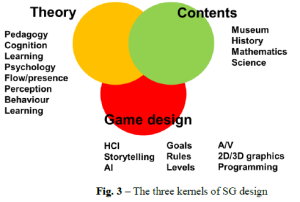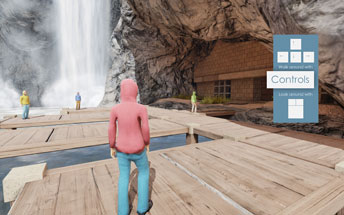De Gloria, Bellotti, Berta and Lavagnino open with a coverage of the state of serious game within the field of education and training. Noting its flexibility and benefits for cost efficiency. They also note some concerns including;
- intended learning outcomes and game objectives (features) may conflict with each other
- ‘suspension of disbelief’ may negatively impact the learning process
- Some socio-demographic group s my be excluded (usabilti, competition, access)
- risk of extrinsic motivation techniques
- with triple A title competition the term ‘game’ may not meet user expectations
De Glorria et al. note the origin of the term “serious game” and and its use around training (eg army pilots etc). Then moves onto classification of serious games, citing a variety of models before presenting the following psycho-pedagogical dimensions (by Kickmeier-Rust, 2009), developed on the foundation of Kickmeier-Rust et al.’s 2007 taxonomy. Which includes;
- Purpose
- Reality
- Social Involvement
- Activity
Serious.gamesclassification.com gets a mention for it’s collaborative approach to classification, built on Saywer & Smith’s Serious Games Taxonomy. Using the dimensions; gameplay, purpose, market, and audience. Also noted is a number of other databases who have structured similar information into description/classification, analysis of game components, pedagogy, deployment, and technology used for development.
De Gloria et al. argues for a multi-disciplinary approach to the design and production of
serious games suggesting a model “the three kernals of Serious Game design”. This figure illustrates the complexity of development and considerations a designer must make.
A few pedagogical theories are covered by Gloria et al.
- Constructionist Learning – These serious games support the theory and allow a space “where the plryer can gain knowledge through exploration and by practice, possibly in collaboration with other people”.
- Cognitive Load Theory – Evidence suggests that guidance from real teachers is required to direct learners, further suggesting that “learning is a complex activity” which requires steps and support with various tools
- Flow (Csikszentmihalyi) – to measure engagement using GameFlow’s eight elements: concentration, skills, challenge, control, clear goals, feedback, immersion, and social interaction
- Personalism – “which stresses user-centered design”, also using game data for teacher to analyse and improve upon
- Nonaka SECI model and Kirkpatrick’s 4 levels of learning evaluation
- Revised Blooms taxonomy (cognitive approach) & Kolb’s Experiential Learning Model – “Good SGs and simulations should allow user to make significant experiences”
Commercial Off the Shelf games (eg SimCity, Civilization) as a solution gets a s very stern warning and caution around selection. Suggesting that games are already victim of over-user, especially by “youngsters”. The authors suggest a table for judging the fitness of games for education purpose.
Examples of Serious Games that the authors explore include CancerSpace (training clinical
practitioners), Remission2 (assisting cancer patients with improved care), Living Worlds (for cultural training in Afghanistan), Real Lives 2010, SimVenture, GoVentureCEO, MarketPlace, The Barn’s TeamUp (fostering collaboration and leadership), and Wilson Island. Additionally, Sandbox style games are considered here, noting the benefits, such as “game forces the player to focus more strongly on problems, which favors knowledge acquisition and retention”.
Assessment, feedback and learning analytics are a key part of Serious games, requiring “appropriate metrics, analytics, tools and techniques for in-game user assessment”. “Proper assessment requires continuously tracking the user in all its game activities, allowing appropriate feedback and also supporting adaptivity and personalization”, done in real-time.
Authors note that there is little literature into the descriptions of and relationships between learning mechanics (techniques included) and game mechanics. Except for the Learning Mechanics-Game Mechanics model (Arnab et al., in press).
Further Reading
Prensky M., “Digital game-based learning”, ACM Computers in Entertainment, vol. 1, 2003.
Gee J. P., What Video Game Have to Teach Us about Learning and Literacy, New York: Palgrave Macmillian, 2003.
Bellotti F., Berta R. and De Gloria A., “Designing Effictive Serious Games: Opportunities and Challanges for Research”, Special Issue: Creative Learning with Serious Games Vol. 5, 2010, pp. 22-35.
Klopfer E., Oterwiel S., and Salen K., Moving Learning Games Forward, Obstacles Opportunities & Openness, The Education Arcade, Massachusetts Institute of Technology, 2009. http://education.mit.edu/papers/MovingLearningGamesForward_EdArcade.pdf.
Connolly, T.M., Boyle, E.A., Stansfield, M.H. and Hainey, T., “The potential of Online Games as a Collaborative Learning Environment”, Journal of Advanced Technology for Learning, 2007
Parsons, D., Petrova, K., Hokyoung Ryu, “Mobile Gaming – A Serious Business!” Wireless, Mobile and Ubiquitous Technology in Education (WMUTE), 2012 IEEE Seventh International Conference, pp.27-10, 2012.
Pew Research Center, The future of Gamification. http://pewinternet.org/Reports/2012/Future-of-Gamification.aspx
Garner, “Gartner Predicts Over 70 Percent of Global 2000 Organisations Will HAve at Least One Gamified Application by 2014″, press release, http://www.gartner.com/it/page.jsp?id=1844115
Clark D., Learning by playing: can computer games and simulations support teaching and learning for post-16 learners in formal, workplace and informal learning contexts? Computer games in education and training. Presentation at LSDA Seminar London, November 2003.
Sawyer B., Smith P., “Serious Games Taxonomy”, Paper presented at the meeting of Serious Game Summit 2008, Game Developer Conference, 2008.
Kickmeier-Rust, M. D., Peirce, N., Conlan, O., Schwarz, D., Verpoorten, D., Albert, D. Immersive Digital Games: The Interfaces for Next-Generation E-Learning? In C. Stephanidis (Ed.), Universal Access in Human-Computer Interaction. Application and Services (pp. 647-656). Lecture Notes in Computer Science, 45556/2007. Berlin: Springer, 2007.
Kickmeier-Rust, M. D. Talking digital educational games. In M. D. Kickmeier-Rust (ED.), Proceedings of the 1st International open workshop on intelligent personalization and adaptation in digital educational games (pp.55-66). October, 2009, Graz, Austria.
Pellegrino, J. W., Hilton, M. L., (2012) Education for Life and Work: Developing Transferable Knowledge and Skills in the 21st Century. Washinton, DC: The National Academies Press.
Chen, J., “Flow in games (and everything else)” Communications of the ACM 50, 4 (April 2007), 31-34.
Lopes R., Bidarra R., “Adaptivity Challenges in Games and Simulations: A Survey” Computational Intelligence and AI in Games, IEEE Transactions on vol.3, no.2, pp.85-99, June 2011.
Liu C., Agrawal P., Sarker N., Chen S., “Dynamic difficulty adjustment in computer games through real-time anxiety-based affective feedback,” Int. J. Human-Comput. Interact., vol. 25, no. 6, pp. 506-529, Aug. 2009.
Chiang Y. T., Cheng C. Y., and Lin S. S. J., “The Effects of Digital Games on Undergraduate Players’ Flow Experiences and Affect,” in proceedings of the Second IEEE International Conference on Digital Game and Intelligent Toy Enhanced Learning (DIGITEL ’08).
Baalsrud Hauge J., Bellotti F., Berta R., Carvalho M. B., De Gloria A., Lavagnino E., Nadolski R., Ott M., Field assessment of Serious Games for Entrepreneurship in Higher Education, Journal of Convergence Information Technology, pp. 1-12, volumes 8, number 13, August 2013.
Bellotti F., Berta R., De Gloria A., Lavagnino E., Antonaci A., Dagnino F., Ott M., (2013a) “A Gamified SHort Course for Promoting Entrepreneurship among ICT Engineering Students”, Proceedings of IEEE International Conference on Advanced Learning Technologies (ICALT) 2013, Beijing, China, July 2013.
Bachen, C. M., Hernandez-Ramos, P. F., & Raphael, C. (2012) Simulating REAL LIVES: Promoting global empathy and interest in learning through simulation games. Simulation and Gaming, 43(4).
Angehrn A., Maxwell K., Luccini M., Rajola F., Designing Effective Collaboration, Learning and Innovation Systems for Education Professionals, International Journal of Knowledge and Learning (IJKL), vol. 5, No. 2, 2009.
Bellotti F., Berta R., De Gloria A., D’Ursi A., and Fiore V., 2012. A serious game model for cultural heritage. ACM J. Comput. Cult. Herit. 5, 4, 2012.
Howell K., E. Glinert, L. Holding, C. Swain “How to build serious games” Communications of the ACM, v 50, issue 7, 2007, pp.44-49.
Arnab S., Lim T., Carvalho M. B., Bellotti F., de Freitas S., Louchart S., Suttie N., Berta R. and De Gloria A., “Mapping Learning and Game Mechanics for Serious Games Analysis”, British Journal of Educational Technology, in press.
References
De Gloria, A., Bellotti, F., & Berta, R. (2014). Serious Games for education and training. International Journal of Serious Games, 1(1).



Leave a Reply